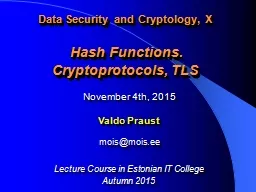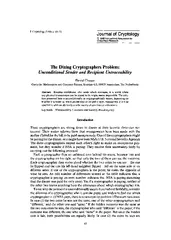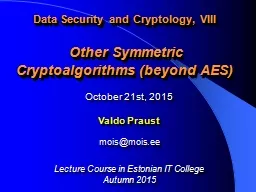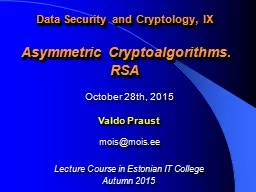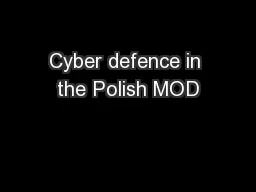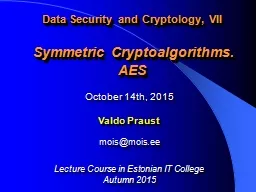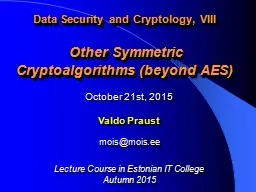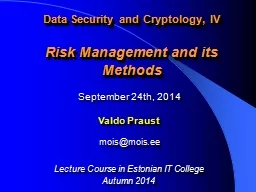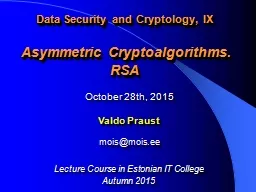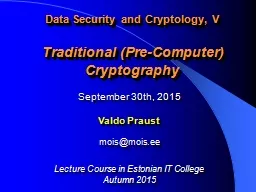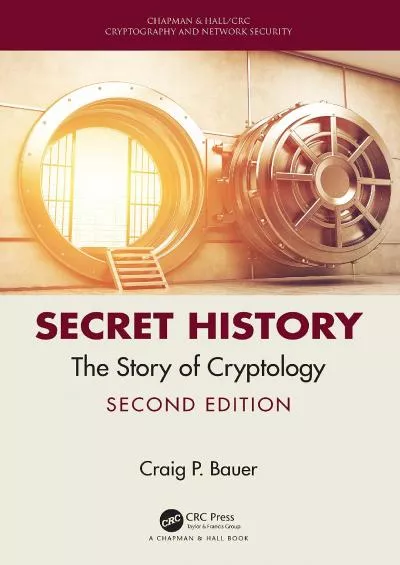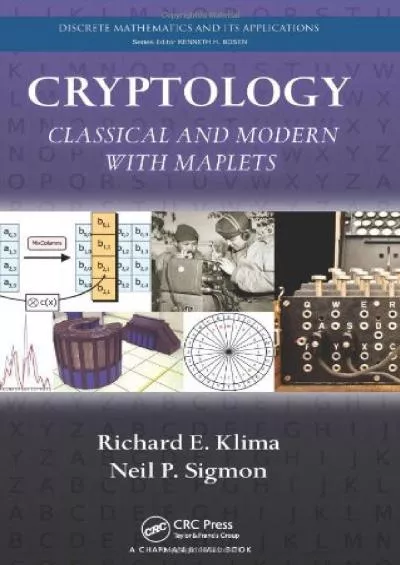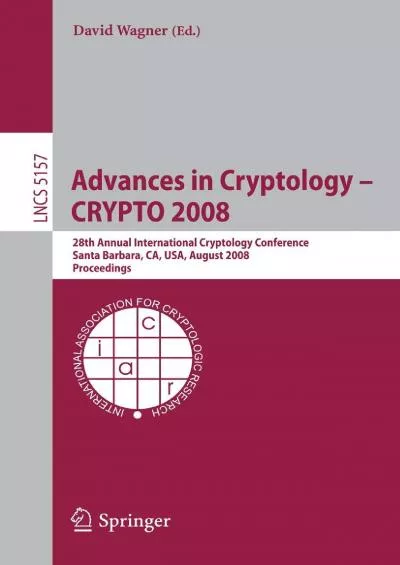PPT-Data Security and Cryptology, X
Author : phoebe-click | Published Date : 2016-12-02
Hash Functions Cryptoprotocols TLS November 4 th 2015 Valdo Praust mois mois ee Lecture Course in Estonian IT College Autumn 2015 Main Types of Cryptoalgorithms
Presentation Embed Code
Download Presentation
Download Presentation The PPT/PDF document "Data Security and Cryptology, X" is the property of its rightful owner. Permission is granted to download and print the materials on this website for personal, non-commercial use only, and to display it on your personal computer provided you do not modify the materials and that you retain all copyright notices contained in the materials. By downloading content from our website, you accept the terms of this agreement.
Data Security and Cryptology, X: Transcript
Hash Functions Cryptoprotocols TLS November 4 th 2015 Valdo Praust mois mois ee Lecture Course in Estonian IT College Autumn 2015 Main Types of Cryptoalgorithms. Cryptology 1997 10 233260 1997 International Association for Cryptologic Research Small Solutions to Polynomial Equations and Low Exponent RSA Vulnerabilities Don Coppersmith IBM Research T J Watson Research C Cryptology 1988 16575 Journal of Cryptology 9 1988 International Association for Cryptologic Research The Dining Cryptographers Problem Unconditional Sender and Recipient Untraceability David Chaum Centre for Ma Other Symmetric Cryptoalgorithms (beyond AES). October . 21st, 2015. Valdo Praust. . mois. @. mois. .ee. Lecture Course in Estonian IT College. Autumn . 2015. . Main Types of Cryptoalgorithms. Asymmetric Cryptoalgorithms. RSA. October . 28th. , . 2015. Valdo Praust. . mois. @. mois. .ee. Lecture Course in Estonian IT College. Autumn . 2015. . . Main Types of Cryptoalgorithms. S. ymmetric cryptoalgorithms. Plenipotentiary of the Ministry of National Defence . of Poland for Cyberspace Security. Director of the National Centre of Cryptology. Brigadier General . Retd. . Krzysztof BONDARYK. Overview. Legal basis. Symmetric Cryptoalgorithms. AES. October . 14th. , . 2015. Valdo Praust. . mois. @. mois. .ee. Lecture Course in Estonian IT College. Autumn . 2015. . Two Stages of Cryptography. Pre-computer cryptography. Other Symmetric Cryptoalgorithms (beyond AES). October . 21st, 2015. Valdo Praust. . mois. @. mois. .ee. Lecture Course in Estonian IT College. Autumn . 2015. . Main Types of Cryptoalgorithms. Risk Management and its Methods. September . 24th. , . 2014. Valdo Praust. . mois. @. mois. .ee. Lecture Course in Estonian IT College. Autumn . 2014. . . Components of Information Security. Info. Asymmetric Cryptoalgorithms. RSA. October . 28th. , . 2015. Valdo Praust. . mois. @. mois. .ee. Lecture Course in Estonian IT College. Autumn . 2015. . . Main Types of Cryptoalgorithms. S. ymmetric cryptoalgorithms. Traditional (Pre-Computer) Cryptography. September. 30th, 2015. Valdo Praust. . mois. @. mois. .ee. Lecture Course in Estonian IT College. Autumn . 2015. . Standard Model of Security Harming. The Benefits of Reading Books,Most people read to read and the benefits of reading are surplus. But what are the benefits of reading. Keep reading to find out how reading will help you and may even add years to your life!.The Benefits of Reading Books,What are the benefits of reading you ask? Down below we have listed some of the most common benefits and ones that you will definitely enjoy along with the new adventures provided by the novel you choose to read.,Exercise the Brain by Reading .When you read, your brain gets a workout. You have to remember the various characters, settings, plots and retain that information throughout the book. Your brain is doing a lot of work and you don’t even realize it. Which makes it the perfect exercise! The Benefits of Reading Books,Most people read to read and the benefits of reading are surplus. But what are the benefits of reading. Keep reading to find out how reading will help you and may even add years to your life!.The Benefits of Reading Books,What are the benefits of reading you ask? Down below we have listed some of the most common benefits and ones that you will definitely enjoy along with the new adventures provided by the novel you choose to read.,Exercise the Brain by Reading .When you read, your brain gets a workout. You have to remember the various characters, settings, plots and retain that information throughout the book. Your brain is doing a lot of work and you don’t even realize it. Which makes it the perfect exercise! The Benefits of Reading Books,Most people read to read and the benefits of reading are surplus. But what are the benefits of reading. Keep reading to find out how reading will help you and may even add years to your life!.The Benefits of Reading Books,What are the benefits of reading you ask? Down below we have listed some of the most common benefits and ones that you will definitely enjoy along with the new adventures provided by the novel you choose to read.,Exercise the Brain by Reading .When you read, your brain gets a workout. You have to remember the various characters, settings, plots and retain that information throughout the book. Your brain is doing a lot of work and you don’t even realize it. Which makes it the perfect exercise!
Download Rules Of Document
"Data Security and Cryptology, X"The content belongs to its owner. You may download and print it for personal use, without modification, and keep all copyright notices. By downloading, you agree to these terms.
Related Documents

